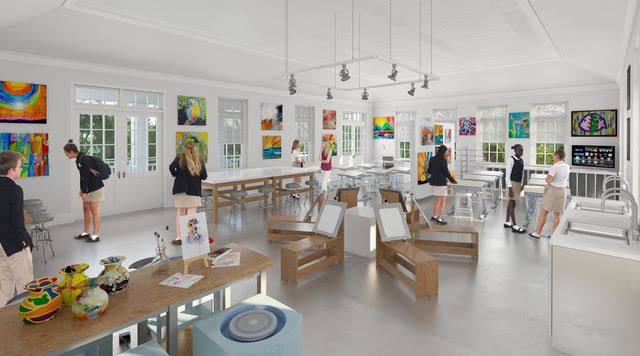Designing an Effective Home Learning Environment (Cooper Robertson)

As many children begin a unique school year of remote or hybrid learning, their parents face the challenge of turning homes into classrooms. For helpful strategies and design solutions, the national experts at Cooper Robertson can offer valuable input.
Known for designing schools and campuses in locations ranging from New York City to the Bahamas, many of the firm’s leaders are now applying this expertise in their own homes. These sources including Cooper Robertson partners John Kirk and Mike Aziz, and senior associate Jason Cadorette, offer a number of considerations relating to home learning environments. These include:
• Reducing distractions. Many adults report struggling with distractions at home while working remotely — and for energetic kids, the struggle can be even more difficult. While computers are necessary for home learning, Cooper Robertson’s experts recommend setting up the learning area as an otherwise electronic-free zone full of soft surfaces such as pillows and carpeting that can absorb and dissipate extraneous noise.
• Creating an active canvas for creativity, including by converting one or more walls into writeable surfaces. John Kirk points to acrylic, plexiglass, and writeable wallpapers as a fun and inexpensive solution. He also notes that cork boards work well for pinning up work and inspirational materials, and additionally have sound-absorbing acoustic properties.
• Lighting strategies for focus and wellbeing. Studies show that higher temperature or “cooler” lighting works better for tasks requiring focus. Keeping this in mind, Cooper Robertson’s Jason Cadorette, AIA, suggests that parents install light bulbs with a higher temperature range in their home learning areas, to ensure children can still focus at night or on overcast days. For natural illumination, top-down blinds are a great way to let light in through the top of a window while also blocking distracting glare at lower levels.
• Flexible spaces that help children learn in their own best way. Whiteboards, storage, chairs and desks should all be flexible enough for children to set them up to their liking. Cadorette recommends investing in easily movable, kid-sized desks and chairs on casters, as well as in a variety of seating options such as bean bag chairs that can serve both learning and fun.
• Adding visual elements that create a classroom feel. Cooper Robertson’s Kirk suggests that any home learning space should incorporate elements that recall a classroom environment, such as a large analog clock, oversized world maps (and/or a globe), the periodic table and posters of inspiring historical figures — and don’t forget all the fun tools either: markers, pencils, crayons, craft paper, paint and brushes.
“As with any learning environment, the at-home classroom should be cheerful, colorful with bountiful natural light, and have an ambiance of ‘fun,’” says Cooper Robertson’s John Kirk, AIA. “Learning is a process involving examination, exchange, exploration, experimentation, failure and success – and the incubator in which this happens needs all the oxygen it can get.”
Other strategies for designing a successful home learning environment include upgrading any outdoor space to serve as a zone for “recess,” or even as outdoor classroom areas for home-based pod schooling groups.


About Cooper Robertson
Recognized internationally for its successes in making thriving places, the award-winning design firm Cooper Robertson integrates architecture and urban design at many scales, from buildings to parks to city districts. Founded in 1979, the firm is led by a core group of diverse and accomplished professionals. Acclaimed works by the firm include large-scale urban redevelopments, major cultural and educational buildings, waterfront resiliency plans, and exceptional residences and resorts. Cooper Robertson is currently active on a number of significant education projects, including an expansion of the Lyford Cay International School in Nassau, Bahamas. This ambitious projects highlights decades of experience in planning and architectural work for educational organizations and independent schools. The projects for Lyford Cay International School are the latest in a long of educational planning and design work, including for the New York Botanical Garden’s Edible Academy and for the Ethical Culture Fieldston School, both in the Bronx, and the Harlem Village Academies High School and Stuyvesant High School in Manhattan. Visit www.cooperrobertson.com.





